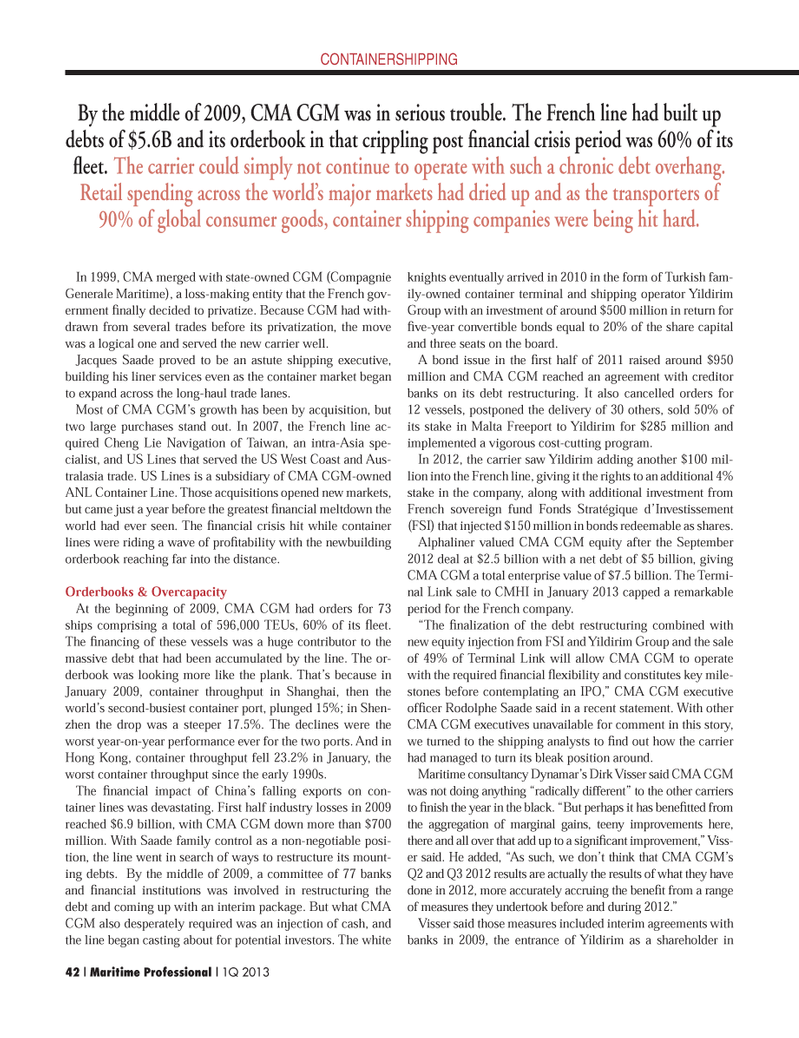
Page 42: of Maritime Logistics Professional Magazine (Q1 2013)
Maritime Risk
Read this page in Pdf, Flash or Html5 edition of Q1 2013 Maritime Logistics Professional Magazine
42 | Maritime Professional | 1Q 2013In 1999, CMA merged with state-owned CGM (Compagnie Generale Maritime), a loss-making entity that the French gov- ernment Þ nally decided to privatize. Because CGM had with- drawn from several trades before its privatization, the move was a logical one and served the new carrier well. Jacques Saade proved to be an astute shipping executive, building his liner services even as the container market began to expand across the long-haul trade lanes. Most of CMA CGMÕs growth has been by acquisition, but two large purchases stand out. In 2007, the French line ac- quired Cheng Lie Navigation of Taiwan, an intra-Asia spe- cialist, and US Lines that served the US West Coast and Aus- tralasia trade. US Lines is a subsidiary of CMA CGM-owned ANL Container Line. Those acquisitions opened new markets, but came just a year before the greatest Þ nancial meltdown the world had ever seen. The Þ nancial crisis hit while container lines were riding a wave of proÞ tability with the newbuilding orderbook reaching far into the distance. Orderbooks & Overcapacity At the beginning of 2009, CMA CGM had orders for 73 ships comprising a total of 596,000 TEUs, 60% of its ß eet. The Þ nancing of these vessels was a huge contributor to the massive debt that had been accumulated by the line. The or- derbook was looking more like the plank. ThatÕs because in January 2009, container throughput in Shanghai, then the worldÕs second-busiest container port, plunged 15%; in Shen- zhen the drop was a steeper 17.5%. The declines were the worst year-on-year performance ever for the two ports. And in Hong Kong, container throughput fell 23.2% in January, the worst container throughput since the early 1990s. The Þ nancial impact of ChinaÕs falling exports on con- tainer lines was devastating. First half industry losses in 2009 reached $6.9 billion, with CMA CGM down more than $700 million. With Saade family control as a non-negotiable posi- tion, the line went in search of ways to restructure its mount- ing debts. By the middle of 2009, a committee of 77 banks and Þ nancial institutions was involved in restructuring the debt and coming up with an interim package. But what CMA CGM also desperately required was an injection of cash, and the line began casting about for potential investors. The white knights eventually arrived in 2010 in the form of Turkish fam- ily-owned container terminal and shipping operator Yildirim Group with an investment of around $500 million in return for Þ ve-year convertible bonds equal to 20% of the share capital and three seats on the board.A bond issue in the Þ rst half of 2011 raised around $950 million and CMA CGM reached an agreement with creditor banks on its debt restructuring. It also cancelled orders for 12 vessels, postponed the delivery of 30 others, sold 50% of its stake in Malta Freeport to Yildirim for $285 million and implemented a vigorous cost-cutting program.In 2012, the carrier saw Yildirim adding another $100 mil- lion into the French line, giving it the rights to an additional 4% stake in the company, along with additional investment from French sovereign fund Fonds Strat?gique dÕInvestissement (FSI) that injected $150 million in bonds redeemable as shares. Alphaliner valued CMA CGM equity after the September 2012 deal at $2.5 billion with a net debt of $5 billion, giving CMA CGM a total enterprise value of $7.5 billion. The Termi- nal Link sale to CMHI in January 2013 capped a remarkable period for the French company. ÒThe Þ nalization of the debt restructuring combined with new equity injection from FSI and Yildirim Group and the sale of 49% of Terminal Link will allow CMA CGM to operate with the required Þ nancial ß exibility and constitutes key mile- stones before contemplating an IPO,Ó CMA CGM executive ofÞ cer Rodolphe Saade said in a recent statement. With other CMA CGM executives unavailable for comment in this story, we turned to the shipping analysts to Þ nd out how the carrier had managed to turn its bleak position around.Maritime consultancy DynamarÕs Dirk Visser said CMA CGM was not doing anything Òradically differentÓ to the other carriers to Þ nish the year in the black. ÒBut perhaps it has beneÞ tted from the aggregation of marginal gains, teeny improvements here, there and all over that add up to a signiÞ cant improvement,Ó Viss- er said. He added, ÒAs such, we donÕt think that CMA CGMÕs Q2 and Q3 2012 results are actually the results of what they have done in 2012, more accurately accruing the beneÞ t from a range of measures they undertook before and during 2012.Ó Visser said those measures included interim agreements with banks in 2009, the entrance of Yildirim as a shareholder in CONTAINERSHIPPING By the middle of 2009, CMA CGM was in serious trouble. The French line had built up debts of $5.6B and its orderbook in that crippling post Þ nancial crisis period was 60% of its ß eet. The carrier could simply not continue to operate with such a chronic debt overhang. Retail spending across the worldÕs major markets had dried up and as the transporters of 90% of global consumer goods, container shipping companies were being hit hard. MP #1 34-49.indd 42MP #1 34-49.indd 422/22/2013 11:21:19 AM2/22/2013 11:21:19 AM

 41
41

 43
43
